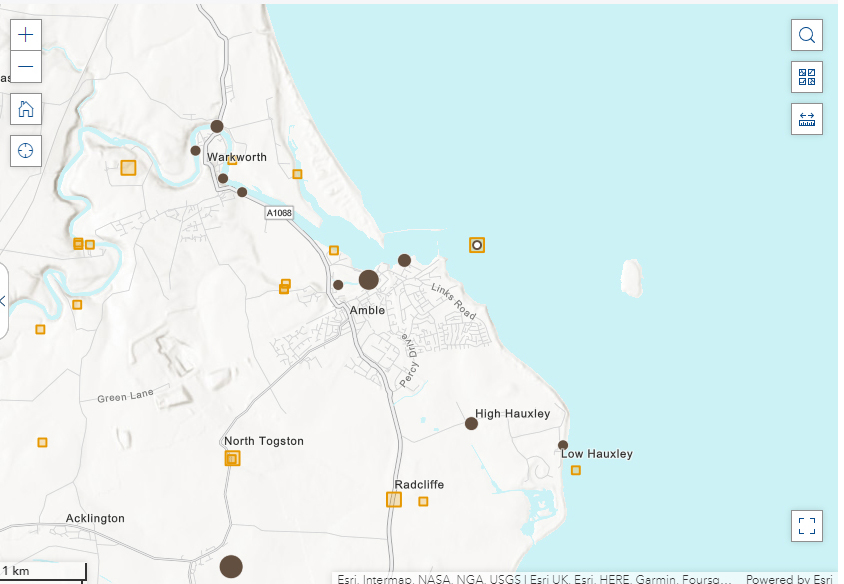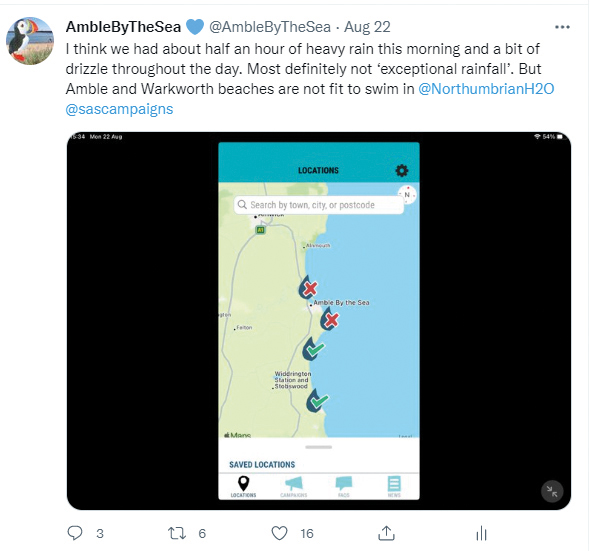Why is sewage discharged onto our beaches?
Please note: this article first appeared in Issue #136 Oct/Nov 2022
Sewage was discharged onto Amble and Warkworth beaches on at least two days in one week this August [2022], although alerts were issued on several more occasions.
Water quality alerts for the Amble and Warkworth beaches were issued on 22, 23, 24, and 26 August [2022]. They appeared on the Surfers Against Sewage (SAS) app, which gets its data in real time from Northumbrian Water (NWL).
When looking on NWL’s own website however, a discharge was flagged only once, on 24 Aug.
Water companies are only supposed to discharge untreated sewage directly into rivers and seas in ‘exceptional circumstances’ such as very heavy rainfall.

Northumbrian Water storm outlets on the River Coquet from Warkworth to Amble. Image from The Rivers Trust
In Amble’s case, discharges are pumped into the River Coquet from storm sewers, and they flow out to sea. Tides and currents then bring the waste back onto our beaches.
The whole country had just been through an exceptionally dry, hot period, and although Northumberland was spared some of the worst effects, neither did we see the flooding and storms which came afterwards.
We asked NWL where the discharges had taken place and why.
A spokesperson for NWL said “On 22 August, Amble/Warkworth SO The Butts, was operated between 08:39 – 10:29 and on 24 August the Amble/Warkworth SO 02 [Turner St] operated between 07:36 to 08:18.”
The spokesperson said “There was significant rainfall on the mornings of both 22 and 24 August, so the SOs were operating as per their design. Under significant rainfall conditions, the storm overflows will discharge to the environment through these pipes what is largely rainwater, mixed with some of the contents of our sewer network from the area affected. This is to avoid the storm water backing up and flooding peoples’ homes and our communities.”
The Ambler’s own observation of the weather at that time was described in rather different terms.

Tweet from The Ambler August 2022
On 22 August our @AmbleByTheSea twitter account showed a screengrab of the SAS beach alert, and we said: “I think we had about half an hour of heavy rain this morning and a bit of drizzle throughout the day. Most definitely not ‘exceptional rainfall’. But Amble and Warkworth beaches are not fit to swim in.”
Under Section 94 of the Water Industry Act 1991, water companies are required to operate, maintain and extend sewage systems capable of dealing with the contents of those sewers.
Using NWL’s own data, in 2021, discharges into the Coquet estuary from sewer storm overflows in Amble and Warkworth occurred for a total of 432 hours.
Anna Williams













One thought on "Why is sewage discharged onto our beaches?"
Comments are closed.